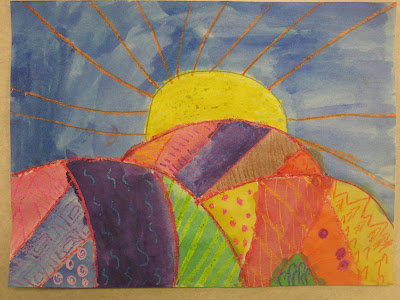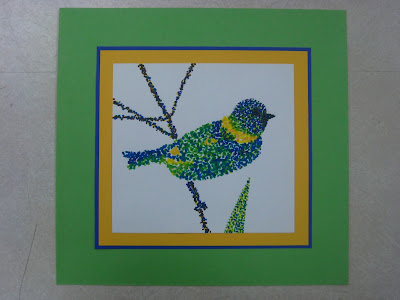A few weeks ago, I posted about pointillism birds that my 5th grade students had created. It was a very successful lesson! I put them all in the hallway this week (every one of them except about 4 that were very unfinished due to multiple absences) and I am really impressed by how good they all look. I'm definitely planning on doing this lesson again next year!
Thursday, April 25, 2013
Thursday, April 18, 2013
Integrating Art and Science
One of the 2nd grade teachers at my school has been growing flowers from seeds with her students. She has a fancy cart with rows and rows of little labeled seedlings under a special lamp. The children have been enjoying watching the seedlings sprout and grow. One of the parents in our Parent Teacher Organization even baby-sat the seedlings during spring break! A few weeks ago, she and I decided that we could integrate her science project with an art project. The students made ceramic flower pots in art class, complete with a little hole in the bottom to drain, and a saucer. We rolled the flower pots (large pinch pots) on texture sheets, and then we glazed them. I am really happy with how these turned out! The students are so excited about the project too; integrating subjects makes everything so much more relevant! Here are a few photographs of finished 2nd grade flower pots:
Tuesday, April 16, 2013
3rd Grade Patterned Landscapes
My 3rd grade students have been learning about pattern and texture. For this project, the students made watercolor resist paintings showing the texture of a landscape by drawing patterns. From high up in a plane, farmland often looks like patterns, with the striped fields, and polka dot trees. I am very happy with how these turned out!
Tuesday, April 2, 2013
5th Grade Pointillism Birds
I love teaching about pointillism. There is so much color theory that can be worked into the lesson. I require my students to mix all of their colors in pointillism. They are allowed to use the actual color (i.e. using the purple marker in making purple), but they need to include other colors as well. Using pink makes a lighter purple than using red (it's pretty hard to make a nice purple using red!). Also, mixing too many colors together usually makes brown, but mixing complementary colors also makes brown. The students had fun experimenting! Last year, my 5th graders made pointillism desserts; this year, we made birds. I printed off about 25 different kinds of birds for the students to choose from. They had to copy the picture in pointillism, recreating the colors in the photo by mixing different colors of marker dots together. The students don't do the background of the picture because at the 5th grade level it would be too confusing to have dots everywhere.
Here are some student examples:
Before the students began their birds, they completed the pointillism worksheet I created. This worksheet helps the students understand the concept of mixing colors with dots. As they work, I allow them to periodically place their worksheet on the blackboard with a magnet so they can look at it from far away. Before they begin the worksheet, I give them lots of ideas for mixing the colors. For example, tan can be included in yellow-orange; to make purple, the students may want to use pink or raspberry instead of red so it won't be so dark.
Here are some student examples:
These two pictures have already appeared on my blog because they have both been displayed at art shows for Youth Art Month:
Before the students began their birds, they completed the pointillism worksheet I created. This worksheet helps the students understand the concept of mixing colors with dots. As they work, I allow them to periodically place their worksheet on the blackboard with a magnet so they can look at it from far away. Before they begin the worksheet, I give them lots of ideas for mixing the colors. For example, tan can be included in yellow-orange; to make purple, the students may want to use pink or raspberry instead of red so it won't be so dark.
Subscribe to:
Comments (Atom)


















































